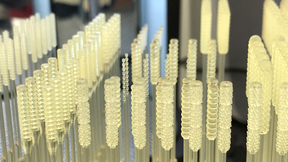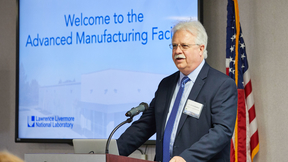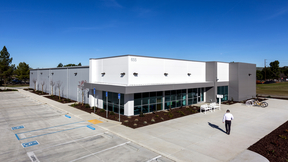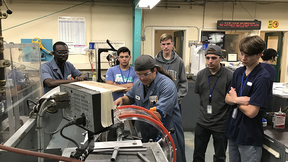Back
In this era of COVID-19, tracking the disease adequately enough to allow state and local officials to lift shelter-in-place orders and return to a semblance of normalcy in the absence of a vaccine will require widespread testing, according to medical experts. However, such extensive testing efforts have been hampered due to a shortage of nasopharyngeal (NP) swabs, the…
Combining high-fidelity computer simulations with ultra-high-speed X-ray imaging, researchers at Lawrence Livermore National Laboratory (LLNL) have discovered a strategy for reducing or even eliminating defects in parts built through a common, laser-based metal 3D-printing process. In work published by the journal Science, a research team at LLNL, along with collaborators…
While hospitals across the U.S. faced a possible shortage of mechanical ventilators due to COVID-19, a self-assembled “skunk works” team at Lawrence Livermore National Laboratory (LLNL) worked tirelessly to prototype a simple ventilator design for quick and easy assembly from available parts. Dubbed the “Novel Emergency Response Ventilator” (NERVe), the design is derived…
The High Performance Computing for Energy Innovation (HPC4EI) Program, managed by Lawrence Livermore National Laboratory (LLNL), has issued a special solicitation seeking industry partners to collaborate with the Department of Energy’s (DOE’s) national laboratories on projects to improve manufacturing processes. This special solicitation invites members of Manufacturing…
Officials from the National Nuclear Security Administration (NNSA) and Lawrence Livermore National Laboratory (LLNL) gathered with elected leaders and industry professionals recently to dedicate and tour the Advanced Manufacturing Laboratory, a new collaborative hub intended to spur public-private partnerships. The $10 million, 14,000-square-foot facility, located in the…
Lawrence Livermore National Laboratory (LLNL) engineers and biologists have developed a “brain-on-a-chip” device capable of recording the neural activity of living brain cell cultures in three dimensions, a significant advancement in the realistic modeling of the human brain outside of the body. In a paper published by the journal Lab on a Chip, LLNL researchers report on…
Officials from the National Nuclear Security Administration (NNSA) and Lawrence Livermore National Laboratory (LLNL) gathered with elected leaders and industry professionals recently to dedicate and tour the Advanced Manufacturing Laboratory, a new collaborative hub intended to spur public-private partnerships. The $10 million, 14,000-square-foot facility, located in the…
The future of commuter traffic probably looks something like this: ride-hailing companies operating fleets of autonomous electric vehicles alongside an increasing number of semi-autonomous EVs co-piloted by humans, all supported by a large infrastructure of charging stations. This scenario is particularly likely in California, which has committed to reducing carbon…
A team of Lawrence Livermore National Laboratory (LLNL) scientists and collaborators from the University of California, Santa Cruz (UCSC) and Sun Yat-Sen University have developed a new class of aerogel electrodes with a simultaneous boost in energy and power density. The research could be a boon for the energy storage industry. “This is the first example in which we were…
WHO: Leaders from Lawrence Livermore National Laboratory (LLNL) and the National Nuclear Security Administration (NNSA), industry partner representatives and Laboratory experts in advanced manufacturing and 3D printing. WHAT: Lawrence Livermore National Laboratory will host a dedication ceremony and media tour of the Advanced Manufacturing Laboratory (AML), a state-of-the…
The U.S. Department of Energy (DOE) today announced the 12 projects awarded funding under the latest solicitation for the High Performance Computing for Energy Innovation Program (HPC4EI), a public/private collaboration that seeks to leverage DOE’s high performance computing facilities at national labs for industry to improve energy efficiency and streamline manufacturing…
The buildup of microscopic residual stresses that occur during the process of 3D printing metal parts can lead to deformation and even cracking in the part, complicating the printing process and resulting in defects that cause damage and part failure. To develop a strategy for mitigating these tiny stresses, Lawrence Livermore National Laboratory (LLNL) researchers have…
While 3D printing at the nanoscale — producing intricate features orders of magnitude smaller than the width of a human hair — has significant potential in industry and commercial applications, wide adoption has been impractical because of the slow speed and low throughput of the most widely used nanoprinting technique, two-photon lithography (TPL). But in the latest issue…
Lawrence Livermore National Laboratory (LLNL) researchers have designed a new class of 3D-printed lattice structures that combine lightweight and high stiffness, despite breaking a rule previously thought to be required to exhibit such properties. One of the new structures additionally displays perfectly uniform response to forces in all directions. As described in a paper…
Foothill High junior Lauren Graham has wanted to be an engineer since she took a class in eighth grade. Still undecided about her precise career path, she wants to expand her knowledge base and learn about all aspects of manufacturing. After seeing the many milling and welding machines, lathes and precision tools used at Lawrence Livermore National Laboratory (LLNL), and…
The multicopter drone’s blades whirred, lifting it off the ground with a distinct hum, kicking up dust and propelling the craft through its preprogrammed flight path. The drone’s operators gazed at their laptop screens, closely monitoring the performance of the drone’s sensors while it carried out its maneuvers. Carrying a payload for the Department of Defense, the drone…
Lawrence Livermore National Laboratory (LLNL) researchers are working with semiconductor chip manufacturer Applied Materials to improve a process for depositing thin-film materials on wafers that are used in high-efficiency LED lights and other products. The Department of Energy’s High Performance Computing for Manufacturing (HPC4Manufacturing) program is funding the…
The High Performance Computing for Energy Innovation program (HPC4EI) today announced the nine public/private projects awarded more than $2 million from the Department of Energy (DOE), with aims of improving energy production, enhancing or developing new material properties and reducing energy usage in manufacturing. The projects represent the first joint round of funding…
Leadership from Lawrence Livermore National Laboratory (LLNL), the National Nuclear Security Administration (NNSA), Livermore Field Office (LFO) and contractor Hensel Phelps broke ground earlier this month on the Applied Materials and Engineering (AME) campus at LLNL. The groundbreaking was for the start of new building construction in the 2200 block of the Laboratory and…
In 3D printing, residual stress can build up in parts during the printing process due to the expansion of heated material and contraction of cold material, generating forces that can distort the part and cause cracks that can weaken or tear a part to pieces, especially in metals. Researchers at Lawrence Livermore National Laboratory (LLNL) and the University of California,…
























